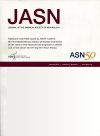Estimation of Proximal Tubular Function by Stimulation of Organic Anion and Cation Transporters
The functional response of proximal organic cation and anion transporters was independent of GFR.Serum levels of protein-bound uremic substrates and urine biomarkers of tubular function were correlated with the organic transporters' response.Urinary creatinine excretion 1 hour after the ingestion of 5 g of creatinine may be used to estimate proximal tubular function.
Background
Tubular pathophysiology plays a critical role in the progression of CKD. Exogenous stimulation of proximal tubule organic anion transporter (OAT) and organic cation transporter (OCT) may be used to evaluate their responses independently of GFR and their relation with clearance of protein-bound solutes and other biomarkers of tubular function.
Methods
A proof of principle study was conducted in nine healthy volunteers and 22 patients with CKD classified by their GFR in Kidney Disease Improving Global Outcomes stages. They were studied hourly during 4 hours with water-induced diuresis, after the ingestion of 5 g of creatinine and intravenous injection of 1–1.5 mg/kg of furosemide, as means to stimulate OCTs and OATs, respectively. GFR determination (iohexol urinary clearance) was conducted in hours 2–3 and 3–4 of the study. Indoxyl sulfate, pCresol sulfate, and urinary biomarkers of tubular function were studied in the first hour.
Results
GFR was stable during the study. Maximal values of tubular secretion of creatinine (TScr) and tubular secretion of furosemide were obtained in the first hour. The Kidney Disease Improving Global Outcomes categories of GFR were widely distributed throughout the range of tubular secretory responses. One-hour stimulated response of OATs was negatively correlated with serum levels of indoxyl sulfate (r=−0.54, P = 0.009) and pCresol sulfate (r=−0.46, P = 0.03). Urinary epidermal growth factor, ammonium, alpha 1 microglobulin, and uromodulin correlated with the increment of TScr and tubular secretion of furosemide. The urinary excretion rate of creatinine in the first hour after the ingestion of 5 g of creatinine was strongly correlated with the TScr (r=0.87, P
Conclusions
The functions of OATs and OCTs of the proximal tubule varied considerably between patients with similar GFRs, and their impaired response was associated with retention of protein-bound uremic solutes and urine biomarkers of tubular dysfunction. The response of OCTs may be estimated by the urinary excretion of creatinine 1 hour after the ingestion of 5 g of creatinine.
Clinical Trial registry name and registration number:
Furosemide and Creatinine Tubular Stress Test in Order to Measure Proximal Tubule Residual Function, NCT05105009.




